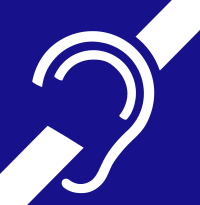
Photo from wikipedia
Background: An electrophysiological investigation with auditory brainstem response (ABR), round window electrocochleography (RW-ECoG), and electrical-ABR (E-ABR) was performed in children with suspected hearing loss with the purpose of early diagnosis… Click to show full abstract
Background: An electrophysiological investigation with auditory brainstem response (ABR), round window electrocochleography (RW-ECoG), and electrical-ABR (E-ABR) was performed in children with suspected hearing loss with the purpose of early diagnosis and treatment. The effectiveness of the electrophysiological measures as diagnostic tools was assessed in this study. Methods: In this retrospective case series with chart review, 790 children below 3 years of age with suspected profound hearing loss were tested with impedance audiometry and underwent electrophysiological investigation (ABR, RW-ECoG, and E-ABR). All implanted cases underwent pure-tone audiometry (PTA) of the non-implanted ear at least 5 years after surgery for a long-term assessment of the reliability of the protocol. Results: Two hundred and fourteen children showed bilateral severe-to-profound hearing loss. In 56 children with either ABR thresholds between 70 and 90 dB nHL or no response, RW-ECoG showed thresholds below 70 dB nHL. In the 21 infants with bilateral profound sensorineural hearing loss receiving a unilateral cochlear implant, no statistically significant differences were found in auditory thresholds in the non-implanted ear between electrophysiological measures and PTA at the last follow-up (p > 0.05). Eight implanted children showed residual hearing below 2000 Hz worse than 100 dB nHL and 2 children showed pantonal residual hearing worse than 100 dB nHL (p > 0.05). Conclusion: The audiological evaluation of infants with a comprehensive protocol is highly reliable. RW-ECoG provided a better definition of hearing thresholds, while E-ABR added useful information in cases of auditory nerve deficiency.
Journal Title: Brain Sciences
Year Published: 2022
Link to full text (if available)
Share on Social Media: Sign Up to like & get
recommendations!